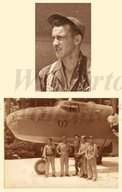
|

|
|
|
|
Robert was born in New York City as one of three sons. His mother died when he was five. His father, Joseph Robert Powers, a doctor's assistant, re-married two years later to Alma La Fink. He died in 1939 when Robert was fourteen. As a teenager, Robert worked in a grocery store six days a week, before and after school. He graduated from Bronx High School of Science in 1943 and promptly volunteered for the U.S. Marine Corps. He completed boot camp at Parris Island, South Carolina, in October of 1943, and then reported to a four-month school for aerial photography at Pensacola Naval Air Station in Florida. One of his instructors was a movie star, Leif Erickson. He learned to shoot with hand-held cameras from airplanes such as the SNJ, SNB and PBY Catalina. He learned film processing in a lab at Cherry Point Marine Corps Air Station in North Carolina, and finished his Marine Corps training with an MOS (Military Occupational Specialty) of 940 (aerial photography) and 945 (lab technician). After a two-week specialized photography course the Polaroid Corporation taught in New York City, Robert left California on the Cape Bon, a Liberty ship. "Not the foggiest idea" he says about his eventual destination when they set sail. Arriving at Guadalcanal after a twenty-one day voyage, the ship went on to Banika Island and a replacement camp. He was sent to Emirau Island of the northern Solomons, arriving in mid-September of 1944. There he was assigned to Marine Air Group Sixty-one, which flew the PBJ, the Marine equivalent of the B-25. While working in photography department, he lived in a pyramidal tent and ate food that he says was "absolutely awful, really awful. Miserable. We lived on coffee and cigarettes. What won World War II was coffee and cigarettes." Early in his service overseas Robert prepared photography lab chemicals and ran the film developing section. He went on his first air strike in December of 1944. In addition to his photography duties on such missions, he manned a 30-caliber machine gun towards the rear of the airplane, but never had to fire. "I think I fired a 50 (caliber) one time for about five rounds. That was about it," he says of his combat experience. On most other sorties he flew in an unarmed photo airplane named "Fuzzy Fotos." In all, Robert flew twenty-two missions. An automatic camera, a K25, was mounted on the plane. The pilot was supposed to click the shutter but, as Robert recalls, "the last thing they thought about was the camera." Larger cameras were used for "recon" photography, providing images of targets, both to plan raids and to assess damage done after a bombing attack. He left Emirau in late August of 1945 after V-J Day. He was delighted to hear the atomic bombs were dropped. "It saved our skins," he says. "Our job in the invasion was to go to Nagasaki harbor on D plus Ten I think it was, low level. I thought, "Oh yes. We would have gotten ours eventually.' It would have been terrible. It would have been horrifying." His unit was moved on LSTs to Mindanao in the Philippines. He flew a few more missions, and then sailed home, departing on November 10, 1945, and arriving November 30. Robert was discharged in February of 1946 at Cherry Point, North Carolina. He later received two air medals. A month later he entered Boston University where he joined ROTC and received a reserve commission in the U.S. Air Force. He re-entered active duty on October 2, 1948, and reported to schools at Randolph Air Force Base in Texas, and then Barksdale Air Force Base in Bossier City, Louisiana. Robert graduated from pilot training September 30, 1949. He was assigned to air rescue service in Westover Air Force Base in Massachusetts where he flew a PBY. In 1952 he was sent to Saudi Arabia. Saudi people, he says, were calm and friendly "as long as you didn't talk about Israelis," he says. "They lose it when they start to talk about Israel, absolutely lose it." He served nearly a year then returned the states and to air rescue work at March Air Force Base in California. He soon went to Strategic Air Command flying KC97 tankers. "A great big bore," he calls that service. He flew the tankers in several locations around the country, including Barksdale. He made lieutenant colonel in 1965 and went to Vietnam with the 374th Tactical Airlift Wing. Based in Taiwan, he flew C-130s in transporting personnel, cargo, and ammunition to Vietnam. Promoted to colonel, he served as deputy commander of operations for the airlift wing. After two years he returned to Eighth Air Force Headquarters at Barksdale, where he retired in May of 1975. He married Beverly Britton Jackson in 1977. Together they have five children and three grandchildren. |


